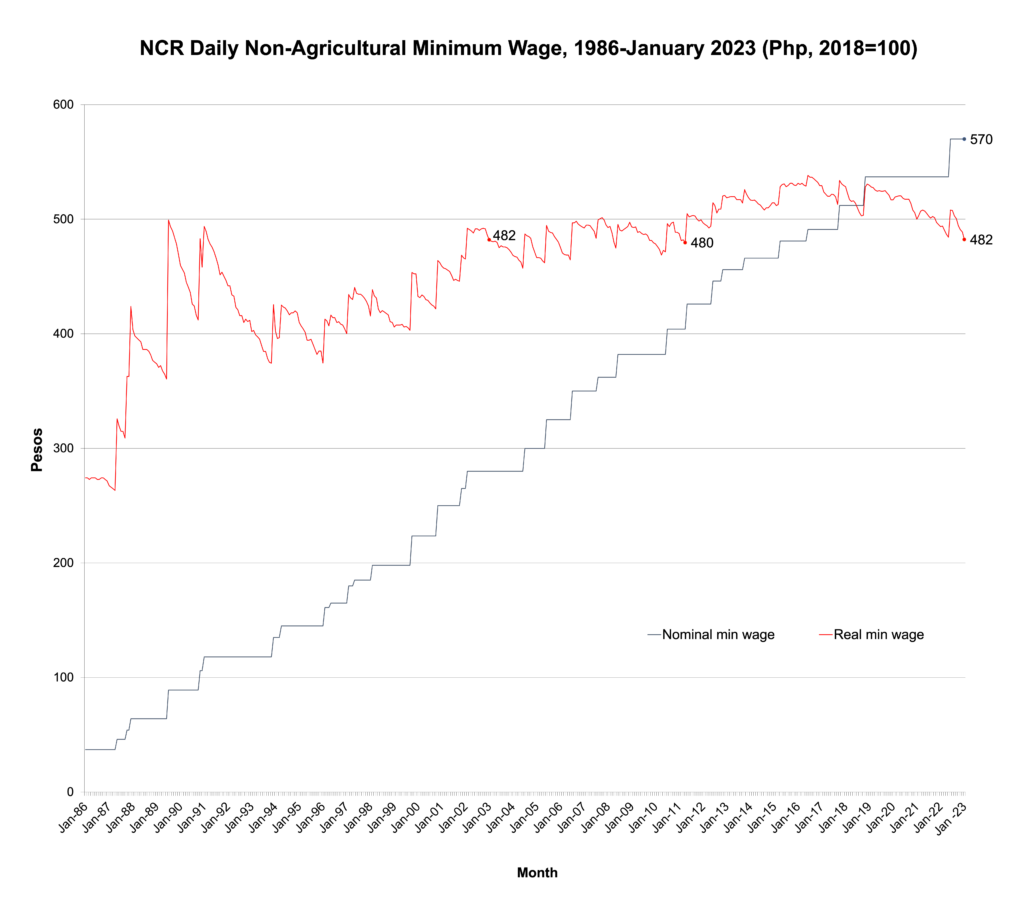Relentlessly increasing inflation in the Philippines is already among the worst in Southeast Asia, exceeded only in Lao People’s Democratic Republic and war-torn Myanmar. The headline inflation rate in January is the highest in over 14 years and is expected to stay high in February. The pressing need of tens of millions of Filipino families for higher incomes to keep up with soaring prices is giving impetus to long-standing calls for wage hikes.
The head of the National Economic and Development Authority (NEDA) responded this week that increasing minimum wages by legislation “does more harm to the economy [than] it benefits.” The economic planning secretary argued that this would hurt the country’s “competitiveness” – referring to the negative reaction that foreign investors might have, and to how cheapening labor is a strategy to increase exports. He also insinuated that worker productivity is not increasing so higher wages are not justified.
“Forcing” a wage increase by legislation is “harmful to the economy,” he added, saying that this is making “wages rise not because the demand for labor is high compared to the supply of labor.” At the same time, he asserted that “the safest thing to do is to increase wages by way of expanding economic activity.”
The adage “Kung gusto maraming paraan, kung ayaw maraming dahilan” (If you want something you’ll find many ways, if you don’t you’ll have many excuses) comes to mind.
Facts
The most obvious flaws in the economic planning secretary’s reasoning are those where the arguments are inconsistent with government statistics and, indeed, with the economic team’s own sunshine propaganda.
Is economic activity expanding enough to increase wages? Recall how the finance secretary and head of the economic team earlier made a big deal about how economic activity is expanding. When the 7.6% growth in gross domestic product (GDP) for 2022 was announced last month, he gushed that this is “our best full-year performance in 46 years” and “among the highest growth rates among major emerging economies in the region.”
Is the demand for labor high enough to make wages rise? The finance department pretty much implied that the demand for labor is high when the 4.3% unemployment rate for December 2022 was announced. They raved that this was “the second lowest since April 2005” and went on about “sustained labor market momentum.”
Is worker productivity not increasing? Official statistics clearly show that worker productivity has been rising. For instance, in the National Capital Region (NCR), worker productivity increased 42% in the last decade from Php791,344 per worker in 2012 to Php1,120,551 in 2021. This is measured as NCR gross regional domestic product (GRDP) divided by total NCR employment, using data from the Philippine Statistics Authority (PSA).
However, there has not been a corresponding increase in workers’ wages. The nominal minimum wage in NCR only went up by 18% from Php456 to Php537 over that same period. This did not even keep up with inflation so the real wage actually fell by 5 percent, measured in constant 2018 prices.
Since worker productivity increases did not go to higher wages these instead went to increasing corporate profits. As a proxy indicator, the net income of the Top 1,000 corporations soared 68% from Php1.08 trillion in 2012 to Php1.82 trillion in 2021. The net worth of the 40 richest Filipinos went up even more – by 89% from Php2 trillion in 2012 to Php3.8 trillion in 2021.
Things are even getting worse since the Marcos Jr administration came into power. Rapidly accelerating inflation since June 2022 has already caused the Php570 minimum wage in the NCR to lose Php29 of its value to only be worth Php541 as of January 2023.
Choices
A deeper problem though is what the economic team chooses to give importance to when speaking about the economy. Unfortunately, their choice is not workers and their welfare.
For instance, there’s something deeply wrong with thinking that “competitiveness” is a race to the bottom to attract foreign investors with the cheapest wages. It’s this kind of thinking that has resulted in real wages in the country falling to its lowest in nearly 12 years (since April 2011) and basically still being at the same level as two decades ago in 2003. (See Chart)

Likewise, there’s something wrong with thinking that wage labor is just another commodity to be priced according to so-called market forces, as if the wage received does not have such far-reaching consequences on worker families’ welfare.
Labor is not a mere commodity to be priced according to the textbook scheme of matching the willingness to pay of buyers (aka employers) to the willingness to sell of workers.
Willingness to pay is not the same as capacity to pay. “Willingness” in the real world really just means employers paying workers as little as they can which increases their profits by as much as possible. This is despite a clear capacity to pay much more. Taking the word of employers that they are already paying as much as they can is belied by all the profits they continue to make.
It’s also not as if workers have any choice but to accept the wages offered them. In the real world, there is really no choice between accepting meager wages and not working and having nothing to feed their families with. It’s an inequality that employers know too well, and that the government unfortunately chronically takes the wrong side of.
Wage-setting should give more consideration to what workers need to live decently especially since employers really do have the capacity to pay much more than they do. Worker wages can be increased if employers were only individually and collectively more willing to give up a share of their profits.
It’s perplexing for the economic team to speak about workers and their wages as if they are a burden to the economy. It’s people who most of all create value in the economy and for whom the economy is for. So, to speak of “the economy” as something different from their conditions and welfare is insensitive and unfair.
That kind of narrow-minded thinking also misses out on the multiplier effects of putting more money in the pockets of workers over booking this as profits and increasing wealth among the richest. The marginal propensity of low-income groups to consume is many times higher than for high income groups so the boost to aggregate demand and spurring economic activity should not be underestimated.
The Philippines has a long history of legislating wage hikes since the 1950s spanning various minimum wage laws, wage orders, executive orders, presidential decrees, and even Republic Acts. The problem is not legal impossibility but dogmatic thinking that labor is just a commodity priced according to what employers choose to pay in the one-sided labor market where workers don’t really have a choice but to accept wages offered or not have any work at all.
It would be nice if the economic managers spoke more consistently about what can and should be done for wage-earning workers in establishments as well as for the vast amount of informal labor in the cities and the countryside. Because, as the saying goes, “Kung gusto maraming paraan.”






